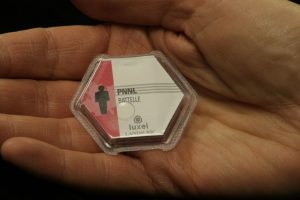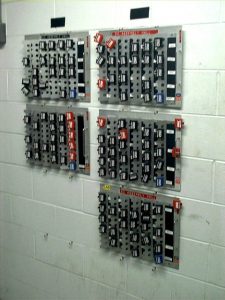Personal Radiation Monitoring Devices: Features and Safety Issues

National regulations determine whether healthcare providers who work in radiology departments require radiation monitoring. In some countries it is mandatory for all personnel exposed to radiation to wear dose-monitoring badges. If individual monitoring is not mandatory, it may be useful to monitor the workplace by placing a dosimeter at a point of interest such as the operator’s position during the image acquisition. In addition, special precautions may be necessary for pregnant workers. Are you monitoring your radiation exposure at work? Do you know the correct way to use your radiation monitoring device? Read about the features of personal radiation monitoring devices used by radiologic technologists.
Film Badges
Film badges are a type of personal radiation monitoring devices. They are essentially dose detectors that measure and record an individual’s exposure to harmful X-rays. A piece of film which is radiation sensitive is enclosed in an envelope that is impenetrable to light. When developed, the film reveals the radiation exposure of the person who was wearing the badge.
One of the main advantages of film badges is that they produce a permanent record of an individual’s radiation exposure. Also, they are reasonably priced. However, a processor is required to develop the film and read the result, a process which is time-consuming. In addition, the results are not instantly available. Also, film badges may give inaccurate results if exposed to high temperatures. It should be noted that although film badges can permanently record the amount of radiation exposure, they cannot accurately measure gamma radiation at less than 20 mrem.
Film Badge Accuracy and Effectiveness
For film badges to be effective and accurate personal radiation monitoring devices, they must be worn properly. During an X-ray procedure, a clip-on badge is typically worn somewhere between the waist and the collar. When not being used, the badge must be stored away from any radiation source. If the film indicates overexposure, an investigation should be carried out. This can determine whether the overexposure was purely accidental or was brought about negligence. Overexposure of a film badge can be due to any of the following reasons:
- Intentional film exposure.
- Improper film storage.
- Inadequate working technique or procedure.
- Failure to use protective shielding.
- Faulty or inadequate shielding.
- Accidentally wearing the badge while undergoing an X-ray examination.
- Lack of awareness about the proper use of the film packet as a non-routine detector of radiation exposure.
- Failure to recognize a questionable film packet as already exposed during non-regular recording of radiation exposure.
Personal Dosimeters
TLDs
Personal dosimeters are similar to film badges and are also personal radiation monitoring devices. They are worn for a specific duration and must be processed to obtain the results. Thermoluminescent dosimeters or TLDs are a common type of personal dosimeter. A TLD consists of a phosphor-containing solid crystal structure. The phosphor in the TLD interacts with the ionizing radiation upon exposure to X-rays. The light emitted from the crystal is proportionate to the radiation exposure and is measured in millirems. The TLD is capable of detecting exposure as low as 1 millirem. However, under normal working conditions, it still has the same low-dose capability as film badges.

For the sake of convenience, personal dosimeters are designed in the form of badges, rings, pens, watches, and phone accessories. Compared to other types of detectors, TLDs are more accurate and have higher low-dose sensitivity. Moreover, unlike film badges which are single use devices, TLDs are reusable. However, it is not possible to obtain an instant result with a TLD, they cannot store permanent records, and the results are not re-readable. A TLD either consists of calcium fluoride or lithium fluoride. The former is used to detect gamma exposure while the latter can detect both neutron and gamma exposure. A TLD is not solely intended for personal use; it can also be used for monitoring environmental radiation exposure.
Luxel Dosimeter
Another type of personal radiation monitoring devices is the Luxel dosimeter. This is based on a technology called optically stimulated luminescence (OSL). It consists of a sealed light and moisture-proof packet containing a sheet of radiation-sensitive aluminum oxide. When the aluminum oxide particles are exposed to radiation, the excited electrons get trapped in their current state. When irradiated with a certain wavelength of light, the electrons release energy in the form of visible light. The emitted light is measured and is proportional to the radiation dose.
The Luxel dosimeter is capable of determining the energy and type of radiation which is harvested through a series of filters in the packet. To be able to determine these parameters, the badge has to be worn with the dosimeter facing the source of radiation. Among all the personal radiation monitoring devices available, the Luxel dosimeter is considered the most sensitive one. It can detect 10 mrem of beta radiation and 1 mrem of X-ray and gamma radiation.
Pocket Dosimeter
A third type of personal radiation monitoring devices is the pocket dosimeter. Unlike the TLD and the OSL, it provides an immediate result of an individual’s radiation exposure. It works for both X-ray and gamma radiation. A common type of pocket dosimeter called the Direct Read Pocket Dosimeter is reusable and provides an instant reading of radiation exposure.
The digital electronic dosimeter is a pocket dosimeter that uses Geiger-Müller counters to detect the dose rate and gather other dose information. It works by collecting the radiation detector output, and once the exposure reaches a predetermined limit, it emits a charge that triggers the digital counter. The accumulated exposure and dose rate are then displayed on the counter.
Some Digital Electronic Dosimeters feature an alarm signal when a specified exposure limit is reached. These two types of dosimeters are most commonly used in industrial radiography; however, they have some disadvantages that must be considered. Like most dosimeters, digital dosimeters cannot permanently store records and have a limited range. They are also prone to data or reading loss as a result of dropping and mishandling.
Most personal radiation monitoring devices of this type can be self-read and feature alarm signals. Users can select specific alarms for early warnings of radiation exposure. The dosimeter can also be set to alarm when high radiation levels are detected. Because it is self-read, the dosimeter instantly displays the readout. Even though it cannot store data, the dosimeter device can be linked to a software program for configuration. The software can be used to receive and store radiation exposure readings.
Low-Price X-ray CE Online
We offer a range of online courses that allow X-ray techs to complete CE requirements for ARRT® and other registries. Please visit our shop to purchase one of our e-courses. This is an easy and convenient way to complete your biannual X-ray CE at a very competitive price.
Here is more information about xray continuing education credits and fluoroscopy CE.
